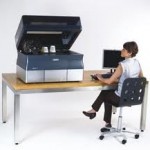Soon, anyone with a computer and a 3D printer can be a manufacturer.
by Antoine Blua
It merited just one line in US President Barack Obama's State of the Union address in February, but it could change the very nature of manufacturing, alter the global trade balance, and potentially spark a new industrial revolution. It is something known as 3D printing, which Obama claimed "has the potential to revolutionize the way we make almost everything."
So what exactly is 3D printing?
The term is actually a colloquial phrase for something called "additive manufacturing" — a process of assembling products by sending a digital file to a machine that stacks layers of plastic, resins, ceramics, metal, or other materials on top of each other.
“It’s going to open up so many new possibilities for new businesses, new business models, start-up companies, entirely new types of products that before were very expensive or impossible to produce.”
Engineers and designers in the automotive and aerospace sectors have been using the process for decades to build prototypes. Many complex parts manufactured by 3D printing are present on aircraft, unmanned aerial vehicles, and satellites. And in the medical industry, three-dimensional printing has also been used to make hip implants out of titanium and dental prosthetics out of ceramic material.
But just as was the case in the computing industry a generation ago, 3D printing technology is advancing rapidly and its cost is falling dramatically. And this means something that was once restricted to a few elite industries is quickly becoming more widely available and affordable. Some three-dimensional printers, for example, now sell for as little as $1,000.
According to Terry Wohlers, president of the US-based Wohlers Associates and a pioneer in the field of 3D printing, the possibilities are practically limitless.
"It's going to open up so many new possibilities for new businesses, new business models, start-up companies, entirely new types of products that before were very expensive or impossible to produce," he says. "So there's a very exciting array of possibilities that are developing as a result of this technology."
The technology is already catching on in some niche industries, including those producing figurines, smartphone cases, handbags, and lamps. Fashion designers are also using additive manufacturing to produce jewelry and clothing, employing materials such as nylon.
Architects, meanwhile, are working on ways to use 3D printing to manufacture building components in concrete. There is even a race afoot to construct the world's first house built entirely with 3D printing products. Researchers are also seeking ways to use the technology to make body parts with biological material, such as cartilage, bone, and skin.
There is a race afoot to construct the world's first house built entirely with 3D printing products. Researchers are also seeking ways to use the technology to make body parts with biological material, such as cartilage, bone, and skin.
At the same time, many schools across the United States are already being equipped with 3D printers.
Wohlers Associates predicts the additive manufacturing industry will be valued at $3.1 billion worldwide by 2016 and $5.2 billion by 2020.
Futurist Thomas Frey, director of the DaVinci Institute in the US state of Colorado, believes 3D printing will “affect virtually every aspect of society" and enable producers to cheaply and efficiently customize their products to meet the specific desires of individual consumers.
“If you can imagine yourself going into a clothing store in the next few years, the first thing that will happen is that they will scan your body and they will send that information to a machine that can print out the clothing that you want," he says. "So you can pick out whatever fashion you want, whatever colors you want, and they'll print it out right there on the spot. And it will not only be your clothing, but it will also be your shoes."
While the "gee whiz" factor of this emerging technology is certainly high, it could have far-reaching implications for the global economy. Many see 3D printing as an opportunity for developed economies to reclaim certain sectors of industrial manufacturing from developing countries.
London-based economist George Magnus suggests that 3D printing could “tilt [the] competitive edge" in manufacturing back to the United Sates, Western Europe, and Japan.
“Why manufacture in China — with all the problems from rising labor costs to governance and [intellectual-property] protection, and with all the costs of shipping raw materials in and finished products out — when you can do all this close to your markets and customers much more cheaply?” he says.
“Why manufacture in China — with all the problems from rising labor costs to governance and [intellectual-property] protection, and with all the costs of shipping raw materials in and finished products out — when you can do all this close to your markets and customers much more cheaply?” he says.
With 3D printing, it is no longer necessary to construct complex assembly lines before production can begin. Factories using the technology also require fewer workers and materials, reducing production costs.
But don't write the obituary for traditional assembly-line manufacturing just yet. Additive manufacturing also has its limitations, according to some analysts.
"Today, 3D printing is less than 0.1 percent of conventional manufacturing in the total services and products made," says Hod Lipson, an associate professor at Cornell University in the U.S. state of New York and co-author of the book Fabricated: The New World of 3D Printing. He believes additive manufacturing still "has a long way to go" before it becomes completely commonplace.
3D printing makes sense for manufacturing highly technical products with complex designs, Wohlers says. But it is less efficient for simple goods produced in high volumes, like stadium seats and trash cans.
The impact of the technology will also be felt in the workforce in developed Western economies. It is much less labor intensive than traditional assembly-line manufacturing, but at the same time it will create a market for more high-tech jobs.
The impact of the technology will also be felt in the workforce in developed Western economies. It is much less labor intensive than traditional assembly-line manufacturing, but at the same time it will create a market for more high-tech jobs.
“Programmers, designers, software and IT personnel, machine minders, and supervisers are the brains — and the brawn input won't be as big,” says Magnus.
As 3D technology spreads, it is bound to raise some important legal issues, specifically regarding intellectual property, copyright, and liability.
"If you print a steering wheel and the steering wheel breaks, who is to blame?" asks Lipson. "Is it the designer, is it the equipment manufacturer, [or] is it the material manufacturer? There are a lot of people in the chain. Responsibilities are not clear."
Lipson adds that the technology is also not without its dangers. He notes, for example, the possibility of printable firearms.
"It's not going to be a military-grade firearm, but it can be in a kind of plastic, disposable firearm that can shoot only a few rounds," he says. "But even that can do damage, especially to the person who is firing the firearm. And that's something that we need to think about."
In Texas, a group called Defense Distributed already runs a website from which gun lovers can download the files needed to produce firearm parts using a 3D printer.
The group has also posted videos on YouTube of rifles firing rounds with 3D printed magazines.
Source




